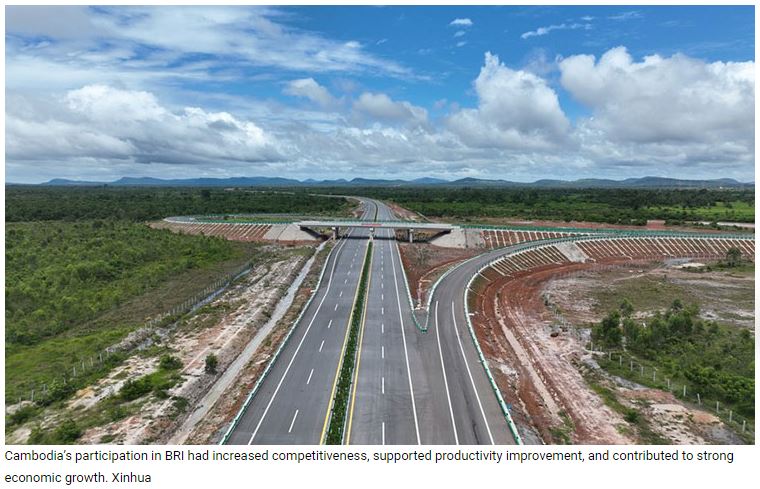BRI helps address ‘infra deficits’ in Cambodia
The Belt and Road Initiative (BRI), a global infrastructure development strategy adopted by China, has helped address infrastructure deficits in Cambodia, said an economist.
BRI has also helped reduce trade and transport costs in the Kingdom, Dr Jayant Menon, a Senior Fellow with ISEAS – Yusof Ishak Institute, said yesterday.
He was speaking at a hybrid seminar jointly organised by ISEAS – Yusof Ishak Institute and Cambodia Development Research Institute.
Presenting the paper at the seminar titled ‘The Belt and Road Initiative in Cambodia: Costs and Benefits, Real and Perceived’, Menon said the economic relations have been strengthened by Cambodia’s active participation in the BRI since its inception in 2013.
Pointing out that China is Cambodia’s largest bilateral donor, lender, investor, and trading partner, he said the country’s participation in BRI had increased competitiveness, supported productivity improvement, and contributed to strong (7 percent average) economic growth leading up to the pandemic.
He also pointed out that there were no significant debt trap issues for the country as, by the end of 2021, Cambodia’s total debt was $9.5 billion, of which 42.7 percent was owed to China. It was around 15 percent of the GDP, he said.
Menon also said the country’s participation had helped improve living conditions and reduce poverty.
However, he also pointed out some costs related to BRI, including the concerns raised over environmental impact, land grabbing, and associated losses in livelihoods.
“The BRI has also been associated, either directly or indirectly, with the development and transformation of the port city of Sihanoukville, he said, adding, “Competitiveness of tradable goods sector can be impaired by the appreciation of real exchange rate due to massive inflows of FDI – Dutch Disease type effects.”
Large BRI projects in Cambodia include the Sihanoukville Special Economic Zone, hydropower plants, Phnom Penh-Sihanoukville Expressway, new Siem Reap International Airport, Morodok Techo National Stadium, roads and bridges, hospitals, rural water supply, etc.
Menon also said the benefits appear to outweigh costs in Cambodia.
“The second BRI Summit in 2019 responded to concerns and improved environmental, social and financial sustainability.
Early signs are that the implementation of projects is becoming more environmentally friendly,” Menon, who had earlier worked with the ADB as Lead Economist, said.
He, however, said the main concerns over inadequate environmental impact assessments and resettlement programmes remain. Menon also said an increasing reliance on a single country for both economic and non-economic needs carries obvious risks. “But the government has been careful to avoid crowding out aid and investment from other sources,” he said.
Hal Hill, the H.W. Arndt Professor Emeritus, Southeast Asian Economies, Crawford School, College of Asia and the Pacific, Australian National University; and Phim Runsinarith, Research Director at the National University of Management in Cambodia, have also expressed their views on the project.
Eng Netra, Executive Director, CDRI, was the moderator of the event.
A Xinhua report published earlier this year quoted Cambodian officials and experts as saying that the projects under the BRI have been greatly boosting Cambodia’s economy and improving local people’s livelihoods.
“These projects have provided and will continue to provide a lot of tangible benefits to the economy and people of Cambodia,” Vasim Sorya, undersecretary of state and spokesman for the Ministry of Public Works and Transport, told Xinhua.
“The BRI projects here are sincere with no strings attached, and their aim is to help boost our socio-economic development and improve our people’s livelihoods,” he said.
Despite the impact of the Covid-19 pandemic, all BRI projects in the country have made headway steadily, Sorya said, giving an example of the construction work on the $2 billion Phnom Penh-Sihanoukville Expressway.
The BRI, a reference to the Silk Road Economic Belt and the 21st Century Maritime Silk Road, was initiated by China in 2013 to build trade and infrastructure networks connecting Asia with Europe and Africa on and beyond the ancient Silk Road trade routes.
Ministry of Commerce’s undersecretary of state and spokesman Penn Sovicheat told Xinhua that the Sihanoukville Special Economic Zone (SSEZ) is a perfect example of win-win cooperation under the BRI.
“The SSEZ has provided a lot of jobs to the workers and served as a role model for the cluster industries and as a base for exports,” he was quoted as saying in the report.
Source: https://www.khmertimeskh.com/501162000/bri-helps-address-infra-deficits-in-cambodia/


 English
English




